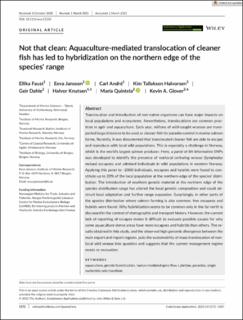Not that clean: Aquaculture-mediated translocation of cleaner fish has led to hybridization on the northern edge of the species' range
Faust, Ellika; Jansson, Eeva; André, Carl; Halvorsen, Kim Aleksander Tallaksen; Dahle, Geir; Knutsen, Halvor; Sanchez, Maria Quintela; Glover, Kevin Alan
Peer reviewed, Journal article
Published version
Permanent lenke
https://hdl.handle.net/11250/2770129Utgivelsesdato
2021Metadata
Vis full innførselSamlinger
- Articles [3012]
- Publikasjoner fra CRIStin [3070]
Sammendrag
Translocation and introduction of non-native organisms can have major impacts on local populations and ecosystems. Nevertheless, translocations are common practices in agri- and aquaculture. Each year, millions of wild-caught wrasses are transported large distances to be used as cleaner fish for parasite control in marine salmon farms. Recently, it was documented that translocated cleaner fish are able to escape and reproduce with local wild populations. This is especially a challenge in Norway, which is the world's largest salmon producer. Here, a panel of 84 informative SNPs was developed to identify the presence of nonlocal corkwing wrasse (Symphodus melops) escapees and admixed individuals in wild populations in western Norway. Applying this panel to ~2000 individuals, escapees and hybrids were found to constitute up to 20% of the local population at the northern edge of the species’ distribution. The introduction of southern genetic material at the northern edge of the species distribution range has altered the local genetic composition and could obstruct local adaptation and further range expansion. Surprisingly, in other parts of the species distribution where salmon farming is also common, few escapees and hybrids were found. Why hybridization seems to be common only in the far north is discussed in the context of demographic and transport history. However, the current lack of reporting of escapes makes it difficult to evaluate possible causes for why some aquaculture-dense areas have more escapees and hybrids than others. The results obtained in this study, and the observed high genomic divergence between the main export and import regions, puts the sustainability of mass translocation of nonlocal wild wrasse into question and suggests that the current management regime needs re-evaluation.
